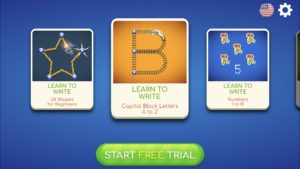I chose to evaluate an app which marries the fun of iPad and the importance of spelling. Letter School is an app designed for young students to practice their letter writing skills in a fun and independent way. The app gives students the chance to work on drawing and identifying shapes, letters, and numbers.
Design wise, the app follows many of Richard Mayer’s multimedia principles in the Cambridge Handbook of Multimedia Learning. The app opens and exemplifies both the multimedia principle, “people learn better from words and pictures than from words alone”(Mayer, 2014) and the spatial contiguity principle, “People learn better when corresponding words and pictures are presented near rather than far from each other on the screen or page or in time”(Mayer, 2014). To do this, the app presents the first three options in a clear and precise manner with the images and text located parallel to each other, as shown in the below picture.

The app also follows the coherence principle by only presenting what information is necessary on the screen at a time (Mayer, 2014). I believe young students may find it confusing if lots of writing was present on the screen directing them what to do; therefore, by simply presenting the singular letter, number, or shape on the screen at a time and having it spoken to the student, I believe the students will find success with the app. Below is a screen recording of a simple example of how the app works.
Moreover, by adding animation and sound effects to the app, the creators fostered the personalization principle. This principle states, “Learners better comprehend text when presented in conversational styles opposed to formal”(Mayer, 2014). For younger students, conversational text is best understood when oral. Because of this, the spoken text is very valuable for students using this app. Using fun animation additionally promotes the personalization principle by communicating with the students in a way they understand and enjoy.
To use this app, it is important for educators to follow Mayer’s “pretraining” principle which states, “By providing students with key information prior to the animation, learners will be able to better understand the concepts they are learning” (Mayer, 2014). In the case of this app, teachers will be required to provide students with both knowledge of the app, as well as, knowledge of the content. For the content to have meaning to the student, they must be made previously aware of all the letters, shapes, and numbers they will be working with.
Finally,the ease of functionality and accessibility when using this app are promising toward making it a powerful multimedia learning tool at the primary level. It is important for students to not become frustrate with learning in order to fully immerse in it and this app allows learners to do so, simply and quickly. I believe this app would fit well in a classroom or for at home learning.
Anstey, L., & Watson, G. (2018, September 18). A Rubric for Evaluating E-Learning Tools in Higher Education. Educause Review. https://er.educause.edu/articles/2018/9/a-rubric-for-evaluating-e-learning-tools-in-higher-education
Theory of Multimedia Learning: http://etec.ctlt.ubc.ca/510wiki/Cognitive_Theory_of_Multimedia_Learning
